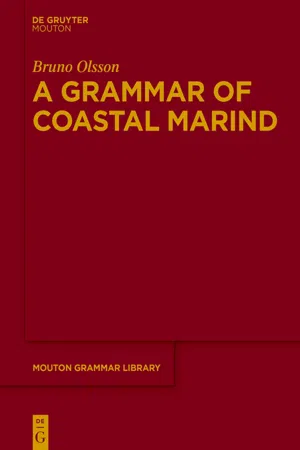
- 608 pages
- English
- ePUB (mobile friendly)
- Available on iOS & Android
A Grammar of Coastal Marind
About This Book
This grammar provides the first modern, comprehensive description of Coastal Marind. It is a Papuan language spoken by the coastal-dwelling Marind-Anim, formerly expansionistic head-hunters of the Southern New Guinea lowlands. Like the other languages of the poorly known Anim family, Coastal Marind features astonishingly complex verb morphology and a range of unusual phenomena, including indexing of up to four arguments on the verb, verbal marking of focus (the 'Orientation' system), engagement prefixes tracking the attention of the addressee, and a system of four genders realised by intricate agreement patterns. The structure of the language is examined in a detailed but accessible way, and its many complexities are brought to life by contextualised spontaneous data, drawn from a rich audio-visual corpus.
Frequently asked questions
Information
1 Preliminaries
1.1 General information
1.1.1 Structural profile
1.1.1.1 Phonology

1.1.1.2 Verbs
| (1) | a. | katal | ip-i-namb-ap- | ig-made | |||
| money | DIST:I/II.PL-3PL>1-1.GEN-CT- | beg:2|3PL.U-PRS.HAB | |||||
| ‘They usually ask me for money.’ | |||||||
| b. | ndom-ago | men-b-u-n-ind-a-y- | kama⟨ɣ⟩in | ||||
| bad-PRWD:III | PERF-ACT-2SG.A-1.DAT-ALL-1.DAT-1PL- | make⟨2SG.U⟩ | |||||
| ‘You ha... | |||||||
Table of contents
- Title Page
- Copyright
- Contents
- Acknowledgements
- List of maps, tables and figures
- Abbreviations and conventions
- 1 Preliminaries
- 2 Phonology
- 3 Nominals, their morphology and derivation
- 4 Pronouns and demonstratives
- 5 Nominal gender
- 6 Adpositions and particles
- 7 The syntax of phrases
- 8 Overview of the verb
- 9 Participant indexing I: The Actor, Dative and Genitive prefixes
- 10 Participant indexing II: Undergoer alternations
- 11 The system of Verb Orientation
- 12 Valence classes
- 13 Valence-changing constructions
- 14 Tense and aspect
- 15 Mood, attitude and engagement
- 16 Distribution of events in time and space
- 17 The Auxiliary, copula clauses and light verbs
- 18 Basic clausal syntax
- 19 Non-declarative speech acts
- 20 Combinations of clauses
- Appendix: Texts
- Index